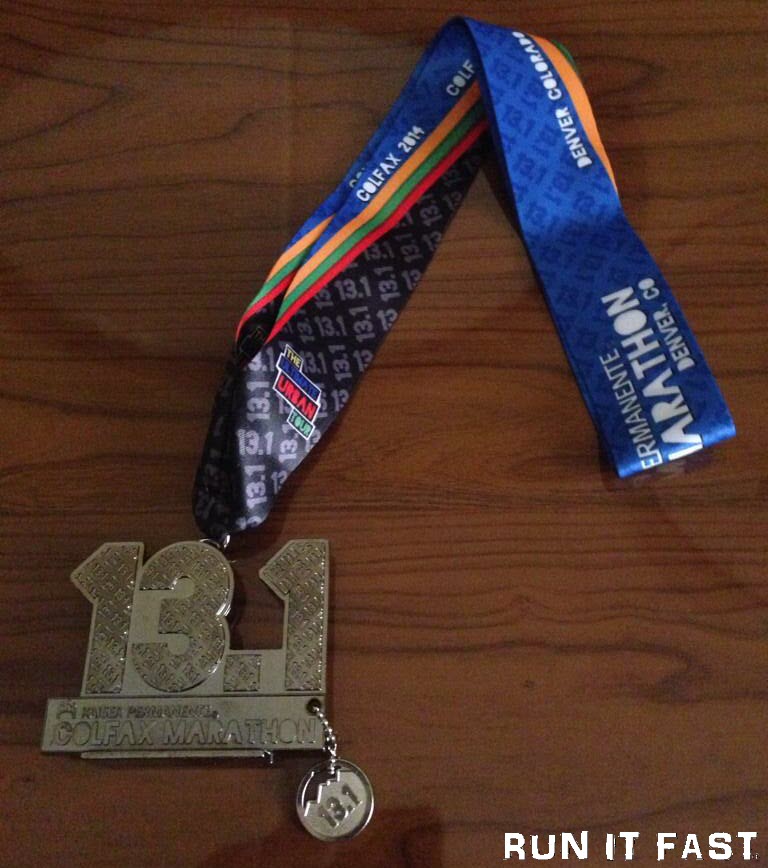
This is the finisher’s medal for the Colfax Half Marathon that was held on May 18, 2014 in Denver, Colorado.
MORE PHOTOS OF MARATHON/ULTRA MEDALS AND BUCKLES
[medal photo submitted by RIF #7 Brad Bennett. Follow him on Twitter @bradb78]

Posted on 21 May 2014.

This is the finisher’s medal for the Colfax Half Marathon that was held on May 18, 2014 in Denver, Colorado.
MORE PHOTOS OF MARATHON/ULTRA MEDALS AND BUCKLES
[medal photo submitted by RIF #7 Brad Bennett. Follow him on Twitter @bradb78]
Posted in Bling, Featured, Half Marathon, MedalsComments (0)

Posted on 10 February 2014.

Here is a massive indexed state-by-state library of all of the marathon, half-marathon, and ultramarathon medals (and more) we’ve received over the past four years.
Enjoy and be sure to Tweet us your medals @runitfast on Twitter or email them in to us.
Posted in Bling, Half Marathon, Marathon, Medals, Ultra MarathonComments (0)

Posted on 17 October 2013.
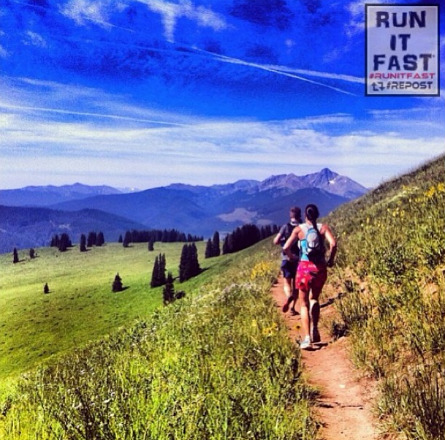
Today’s featured #RunItFast Instagram of the day is from HoboMom.
You can follow HoboMom on Instagram @hobomom
Keep up the good work! #runitfast
More than 33,000 running photos have been tagged on Instagram with our hash #runitfast.
Follow Run It Fast on Instagram @runitfast and use the hashtag #runitfast for a potential feature on Instagram and here.
Posted in InstaFast, Instagram, RunningComments (0)

Posted on 11 September 2013.
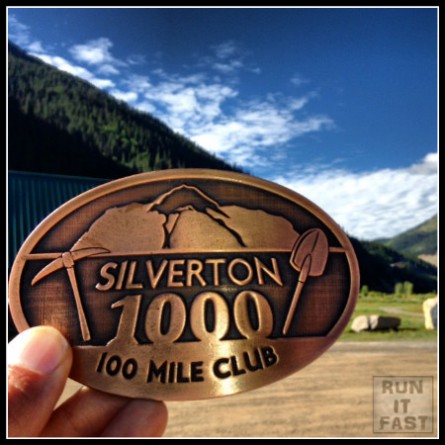
“The gods had condemned Sisyphus to ceaselessly rolling a rock to the top of a mountain, whence the stone would fall back of its own weight. They had thought with some reason that there is no more dreadful punishment than futile and hopeless labor.” – Albert Camus
The Silverton Challenge 48 Hour Race Report
The gods were Mark and Sharill Hellenthal. The condemnation they had laid down on us runners was a 1 mile loop in the mountains of Silverton, Colorado at 9,500 feet with a gain of 250 ft per mile and a subsequent loss of 250 ft per mile as well.
Others must have committed far worse sins for they had been sentenced to six days and three days on that mountain, repeating that same punishing loop over and over. Some even dared to piss off the gods by bringing tents to sneak naps and breaks in. A portable shower was even spotted, but even it couldn’t diminish the stench the mountains had left on the imprisoned runners of Silverton.
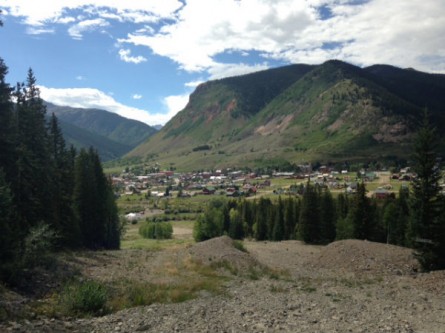
My journey to the mountain was complicated, two flights to Albuquerque then a 5.5 hour drive to Silverton. In retrospect it was the calm before the storm. I checked into a small cabin, then headed over to prison headquarters, where I knew my sentence was to begin the next day. I picked up my prison number and spoke for a bit with the gods behind a veil curtain so that they could keep their omnipresence spell over us that had been sent there.
While there I saw the long faces and worrisome looks from the six and three day runners. They looked at me with jealousy knowing I was soon to retire to my cabin before returning the next day, but they also looked at me with sympathy knowing I had no clue what was about to happen to me the following morning at 9am.
I slept well that night, showered the next morning, and showed up early at the barracks to begin my sentence. I had assumed that this might do me some favor with the gods. It wasn’t the only faulty assumption I had over the next 48 hours.
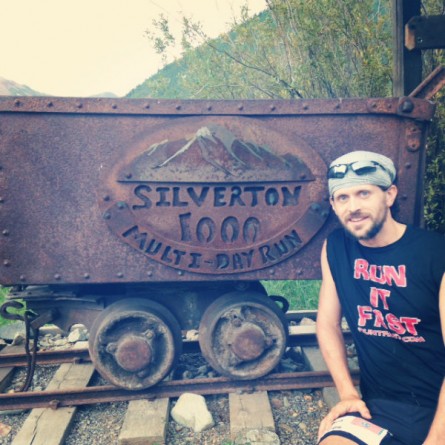
The games of the gods began promptly at 9am after a group photo. The photo I assumed was to remind us eventual survivors that we had been the fortunate ones. The race started and those not long for this earth started sprinting up that mountain. We saw them again within 5 minutes as the altitude had filled their lungs and gravity had harnessed their pride back towards the laughter of the gods.
Two hundred and fifty feet of climb over a mile would be punishing enough but no, that would have been too easy for some. The 250-ft climb happened in the first 0.33 mile to the summit where we’d catch our breath, run on level ground for roughly 25 yards before our heads started falling ahead of our feet and our legs wouldn’t stop. Our legs were moving at a warped speed as we couldn’t slow down, we couldn’t stop and our minds were searching and begging for the slightest incline so we could slow down. Some thought they had fallen into a black hole. No inclines were to be found. Our quads ignited, rocks beneath our feet gave way as we were moving too fast and cutting too hard on switchbacks down towards the gods, and spots in our shoes became hotter than molasses on a Tennessee sidewalk in the heart of summer.
The 250-ft asteroid-like fall from the summit back to flat land took just 0.25 of a mile. Flat land had never felt so secure before. It was also time to walk for a few seconds to let the muscles in the leg rescind back to where they normally reside. A third of a mile later we were back at the tented residence of the gods. The tent was full of food, drink, and mocking. The treats were an oasis of hope that did just that…it made us forget the punishment we had just endured and before we had realized it, we had exited the tent, usually with cookies or gummy worms, and were scaling back up the mountain towards the summit.
I went into Silverton hoping and wanting to reach 100 miles to repay my sins. I didn’t know if the angels would call before I reached that distance, but I thought that once I reached it that my sentence on the mountain would be over and that the gods would release me.
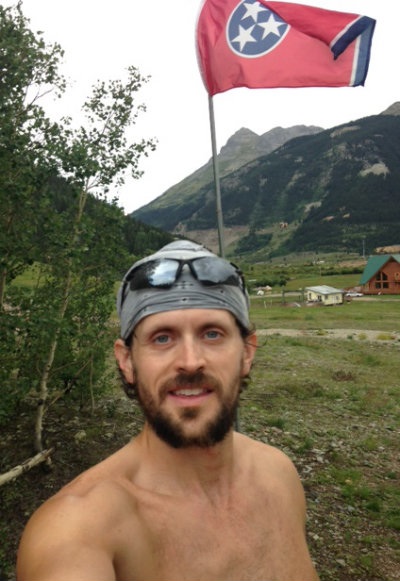
Just five miles into this spectacle, my hamstrings, calf muscles, and feet were begging for no more. They had run 100 miles the weekend before at the Lean Horse 100. I didn’t believe I’d be able to reach 100 miles on this hellanthalish mountain loop. I knew I could stop at any time, since it was timed, but that the gods would laugh, mock, and scorn me by flashing me with the 100-mile buckle I had fallen short of before decapitating me. Foolish pride and a constant restocking of gummy worms and grilled cheeses (upon request) kept me leaving that tent and going back up and down that mountain 100 times over.
After 100x up and down that mountain I had reached 25,000ft of gain and 25,000ft of loss. A hundred times should have been enough. It had taken 35 hours 42 minutes and 44 seconds.
There was one problem…the male and female that did the most loops on this mountain in 48 hours would receive a free pair of Hoka One One shoes ($170 value). It was a mean and cruel trick by the gods that toyed with two of our deadliest sins – pride and greed.
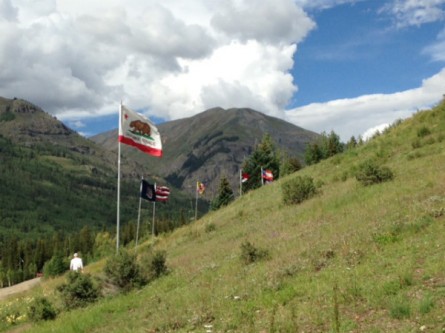
That’s when I realized a 12-yr old boy by the name of Colby Wentlandt was in second place and on my heels. Twelve years old and sentenced to 48 hours on this mountain. What was his crime? How serious must it have been for him to be sentenced with the adults? Had his parents abandoned him while passing through Colorado? Had he murdered his parents? It turns out his parents were on that mountain too, doing painful 1-mile loop after another, but they were so many miles behind young Colby.
Colby moved at such speed it was as if he we was hoping that he could improve the fate of his parents if he could do more miles than any of the other prisoners. However, the gods had no rollover miles plan where he could convey his bounty to his mom and dad.
Colby would taunt me when we’d cross paths under the tent of the gods. He’d tell me how tired I looked and how I should go down. I’m not sure if he meant I should take a nap or if someone with a longer rap sheet should put me down behind the barn. He was sneaky wicked like that and it helped keep me alert and on my toes. I made sure to stay on the opposite side of the mountain to keep him from sneaking up behind and cutting me.
He was easy to spot from the high side of the mountain as he was always with shady characters like a Jester that went by the name of Ed Ettinghausen and two other munchkins by the names of Brandon and Cameron Plate (all sentenced to the 72-Hour and trying to keep up with 48-Hour Colby).
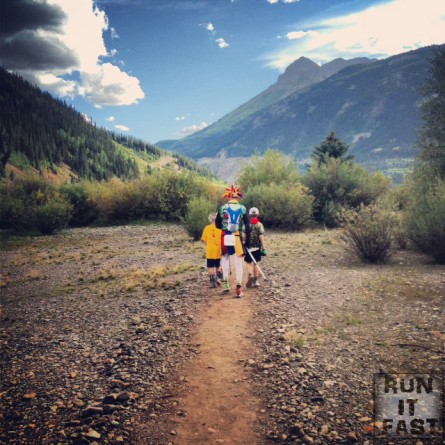
The taunts continued among the inmates as the night became late. ‘The Jester’ and ‘The Boy’ kept putting down 1 mile after another as Colby started to get close to tres digitos. I remained roughly 6-7 miles ahead of Colby per the prison LCD screens that were connected to our anklet tracers.
Colby hit 100 miles (his second time to reach said distance) and everyone within the tent celebrated briefly for most still had many loops left to complete before any hopes of being pardoned from Silverton.
I came in after 107 miles to learn that Colby the Cannibal had retired for the night after 101 tough and strenuous miles. I had met a rough, rugged, and dreaded female convict by the name of Sarah Johnson during these early AM miles. I had spotted a wild bear during this time as I stumbled across one of the ridges high up on the mountain. The bear was a hundred feet away or so looking for food (or bearded runners) in a dumpster near the ski lodge.
I reported the bear to the gods and they called other gods with badges. The gods had planted the bear for us prisoners. My mistake was reporting the creature as the gods then scared the bear back up the mountain near our trail where dozens of us were still circling around in the dark.
The ‘Dreaded One’ stayed close either due to fear of the bear, thinking I had Oreos, or because she couldn’t figure out if her headlamp had an actual light. The company was nice even if albeit fundamentally radical.
“Often the best guys are just those that can suffer longer, who don’t give up. And it’s so easy to give up, when you’re on a mountain and it’s really hurting.” – David Millar
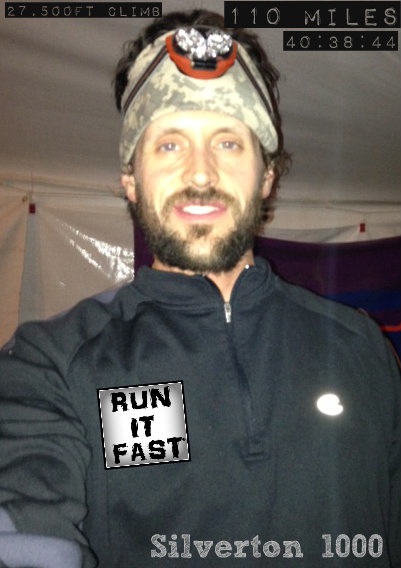
After 110 miles (in 40:38:44) which was a new course record I decided I needed to attempt some rest and sleep as I planned a 6 hour drive back to Albuquerque to catch my flight upon my anticipated release date of 900 hours. I knew I had to be sneaky to dodge the gods so I curled up in the back of my rental car and probably slept for 90-120 minutes.
I was paranoid that Colby had arisen early (thinking it was a school morning) and gone back out on the course for more miles before the sun came up. I went back over to the holding tent and found out that Colby was still fast asleep and far away.
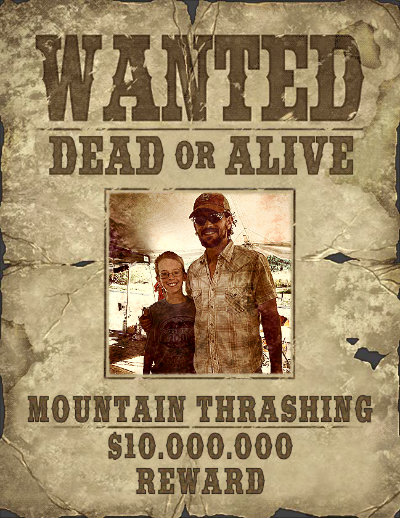
I was surprised to win the race and even more impressed by Colby’s 101 miles and second place finish.
There was great joy celebrating the liberation of several of my fellow companions on the mountain as they came in after 100 miles or more. Some of the highlights were seeing Eric ‘The Fireman’ Waterman complete 100 miles after several failed pardons during other prison stays. Collen Zato was impressive in setting the 72-Hour female course record while setting up several touchdown celebrations for others as they reached memorable milestones during the event and by pacing Rachel Spatz to the female 48-Hour course record. The Jester set a male 72-Hour record for most miles on the course with or without a Jester costume. I was impressed watching Rob Distante who arose from the dead (almost literally) on day two and ran out the rest of his sentence to reach 100 miles. All four Run It Fast – Club members went over 100 miles.
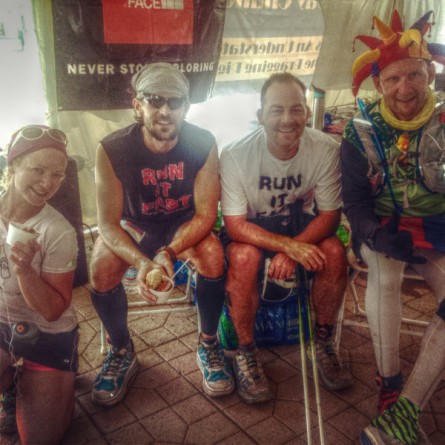
“Never measure the height of a mountain until you have reached the top. Then you will see how low it was.” – Dag Hammarskjold

The gods were cruel but the punishment was cleansing like a toxic bleaching to the soul. The mountain had beaten us down physically yet our bodies were renewed from the pounding. We left the mountain not knowing if we could survive again on the outside. Many of us knew we couldn’t and we’d be back. Some of us knew that the gods would not give us a choice either way.
“Because in the end, you won’t remember the time you spent working in the office or mowing your lawn. Climb that damn mountain.” – Jack Kerouac
– joshua holmes (Aug 31-Sep 2, 2013)
Posted in Race Reports, Running, Ultra MarathonComments (2)

Posted on 18 August 2013.
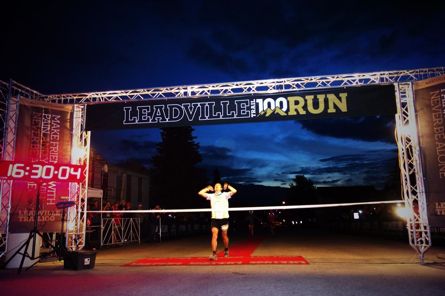
Ian Sharman won the Leadville Trail 100 Run (FULL RESULTS) on Saturday evening in 16:30:04, the fourth fastest time in the event’s history. He was even faster in writing his Leadville race report as it was posted bright and early this morning.
Sharman stated that his body wouldn’t let him sleep so he got to writing. We are the beneficiaries of his sleepless night as he delivered a to the point race report full of his thoughts at different points of the race.
Here are a couple of excerpts from his Leadville Report:
How He Attacked Hope Pass as a Flat Lander: “I decided fairly early on that since I live at sea level and the race is almost all above 10,000ft I’d need to keep my perceived effort down to make my legs and energy reserves last the whole way. Plus I’d already run the other 100 milers recently so wanted to be conservative due to that too. So I hiked every step of Hope Pass both directions but I practice that a lot since I’m not a strong uphill runner and it seemed to work well since I got into second by the top (12,600ft) on the way out, although Nick and Ryan were just behind. Ryan dropped at this point with back problems after looking so strong through the first half.”
His Lowest Point: “Things kept going well through to the Outward Bound aid station at mile 76 and my crew and pacers, Meredith Terranova and Sean Meissner were looking after me well. Hiking up Powerline in the next few miles I still felt fairly good but by about mile 82 things turned and I felt delerious. On the downhill trail into Mayqueen (86.5 miles) I was dizzy and almost tripping over every rock. Nick managed to close on me during this section although I had no idea. Then after Mayqueen a toilet stop seemed to bring me back to life and I was able to cruise along the rolling lake single track.”
Click over to Ian’s website (HERE) to read his complete Leadville Trail 100 Run Race Report.
[image: iRunFar]
Posted in Race Reports, Running, Ultra MarathonComments (0)

Posted on 18 August 2013.

Ian Sharman was terrific on Saturday in Colorado and won the 2013 Leadville Trail 100 Run with a winning time of 16:30:04 which is the 4th fastest in race history according to iRunFar.
Sharman finished over 45 minutes ahead of second place finisher Nick Clark who finished with a time of 17:06:29.
After Ian and Nick there was a rather large gap before Michael Aish, who led a large portion of the race early on, finished in 18:27:59.
The rest of the top 10 for the men was rounded out with Kyle Pietari (4th), Andrew Catalano (5th), Timo Meyer (6th), Eric Sullivan (7th), Scott Jurek (8th), Bob Africa (9th), and Javier Montero (10th).
Leadville Trail 100 Top 10 Men for 2013
Ashley Arnold was the female winner of the 2013 Leadville Trail 100 Run with a winning time of 20:25:43.
Arnolds winning margin was 2 hrs 17 min over second place finisher Shaheen Sattar who finished in 22:42:42. Closely behind Sattar was Keila Merino in 22:47:36.
The remaining Top 10 Women were Katrin Silva (4th), Rebecca Hall (5th), Kara Henry (6th), Abby Penamonte (7th), Maddy Hribar (8th), Nicole Studer (9th), and Margaret Nelsen (10th).
Leadville Trail 100 Top 10 Women for 2013
Congrats to all of these runners, all of the LT100 finishers, and to all of the LT100 starters.
Full Leadville Trail 100 Run Race Results
[image: iRunFar]
Posted in Results, Ultra MarathonComments (0)

Posted on 19 November 2012.
The climb up here was spooky. No rock climber would call it technical, but it was steep and high and you had to hold on. When I’d first looked up and seen the arch I’d thought, a hole to the sky.
Why would two old endurance guys seventy-plus-years-old be climbing on rocks? The short answer of course is we’d climbed up to get a closer look at the arch, one of no particular distinction, at that, one lacking even a picturesque name.
We climbed back down from Natural Arch, which is scarier than climbing up. I started a run at the base of the cliff. Joel’s plan was to drive his truck down the single-track some six miles, park on Old Woman Road and ride back to meet me on his mountain bike. It was a cool day and getting lost in the wilderness wearing running shorts was a bad idea. Since I’d never been to this place before, prior to leaving he decided to give me some advice.
“Remember, when you come to the tee, go left.”
“Right! When you come to a fork in the road take it.”
“Right,” he said.
Left, it was. We understood each other.
Read the full story by Dallas Smith by clicking HERE
Posted in RunningComments (0)

Posted on 24 August 2012.
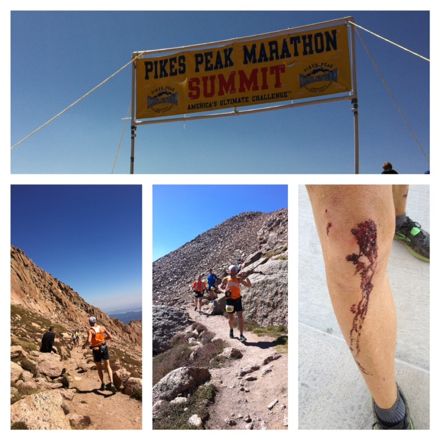
PIKES PEAK MARATHON – August 19, 2012
Many of my past running journals were painfully long, going into every intricate detail of my subject experience. With this entry, I want to hit the high points and hopefully preserve a great memory without writing a book.
My friend Karl Studtmann convinced me to register for The Pikes Peak Marathon. He actually registered for me while Angie and the kids and I were on a spring break cruise. Unfortunately, Karl suffered a knee injury and was unable to run the race. As always, Karl was a great friend and support throughout the entire experience. I know he was disappointed that he wasn’t returning to Pikes Peak in 2012, but he only expressed excitement for me and my chance to run this race. He followed every detail of my training and advised me along the way. He checked in with me right up til the night before the race and made the experience even more special
As with every such event there is lots of planning and discussion that went into it, not to mention a whole bunch of training. For this event I trained differently in that in addition to trail work, I also did weekly treadmill steep incline workouts that were much tougher than I anticipated. Once a week, I would put the treadmill on an 18% grade and then put in over an hour as fast as I could manage to go. That workout is tougher than any speed work that I have ever done. On the trails, I logged countless hours, and ran the marathon distance or farther 5 times between May and August.
Another friend, Josh Holmes was also registered for the race and with Karl out Josh split the hotel in Manitou Springs Co with me. It was really nice to get to visit with Josh because we had never spent any one on one time together. We both arrived the day before the race (I flew in late because August 18, was my son Weston’s 13th birthday!!). Nothing like 12 hours of altitude acclimation! On my flight from Nashville to Denver, I spilled the drink of the guy sitting next to me and so I bought him a replacement. He was so grateful that he started telling me that he was a digital artist and he gave me one of his signed art pieces. Pretty cool!
I drove from Denver to Colorado Springs and then on to Manitou Springs. When I drove into Manitou I could see Pikes Peak looming, glaring, intimidating. I remember sending Karl a text and saying “OMG, What have you gotten me in to?” What an incredible mountain. Manitou Springs is an interesting little town. It’s like you stirred Gatlinburg and an adobe village together in a bowl.
Josh and I met up and went over to the registration and then ate at the pre race pasta dinner. We listened to the guest speaker, Bart Yasso give his talk. Afterward we got to meet Bart and had our pictures made with him. Bart is called the Mayor of Running and the Yasso 800s are named for him.
Josh and I made the ritualistic night before prep for the race and then I went to bed. I slept surprisingly well considering that it was the first night at altitude and the fact that I had a race the next day.
On the morning of the race, we awoke at 5:00, ate a bit, and got ready and planned to walked mile to the starting line. Interestingly when we made it to the street a race volunteer pulled over and offered us a ride. Just as we got in the car, we saw two huge mule deer bucks, with giant racks still in velvet, just hanging out on the edge of the main drag through Maintou Springs.
We took pictures at the starting line and then waited anxiously for the start. We had the first female marathon finisher to give the official start. The first mile is on the roads but it is a pretty steep incline through the storybook little town. Thereafter, you hit the trail and go up and UP AND UP!! To say that I could feel the altitude from the start is an understatement. Nevertheless I was proud of my time during the ascent. The race is historic and it has numerous well know points: No Name Creek, John Barr Trail, Barr Camp, The A Frame, Cirqure, and of course a little spot called the summit which is over 14,000 feet up.
The scenery is breathtaking. Another one of those places where you get a overwhelming sense of how our Creator made our world in a way that is far beyond what can imagine, describe or capture with a photo.
The vegetation changes as you climb and I wish I knew more about the flora and fauna to describe what I saw. Initially, there is heavier vegetation and mainly fir trees. Around 8000 feet or so, it seems to become more Alpine, and the evergreens are blended with Aspen trees. After so many years of snow skiing, I kept having the urge to cut off the trails and start carving my way down the mountain through the trees.
I really surprised myself over the first dozen miles. I was able to run pretty much whenever the traffic would allow me to do so and I was getting really excited about the time that I was making. I felt good considering (considering that there is no oxygen).
I am not sure the altitude above which the trees can no longer grow, but the moment you breakout above the tree line, it is like being on another planet. The Rocky Mountains have that name for a reason. With no tree cover, the wind feels like its howling. The temperature from 12,000 to above 14,000 feet stays in the 30s or below pretty much year round. The view is indescribable so I won’t try. I had to fight the temptation to look at the mountains and take my eyes off the trail. I learned a month or so before the race that “God Bless America” was written from Pikes Peak, and now I know why.
The last two miles before the summit became a little frustrating because of the runner created bottle neck. The elite runners, including the winner Killian Jornet, had reached the summit and were making their descent. Uphill runners must yield to downhill runners, so despite the fact that I had the physical strength to run at miles 11-13, I was forced to hike or climb at a 20+ minute pace. Thus, instead of reaching the summit in under 3:30 as I was thinking, I reached at about 3:50.
The summit was awesome, but candidly I regret that I didn’t stop and savor it a little more. I looked around very briefly and then made the turn to start the descent. Karl told me that I would immediately feel relief as soon as I started back down and he was right. The mile below the summit is really a rock quarry and there is as much climbing as there is running. Thereafter, the rocks and boulders are a little more spread out and running becomes easier. At some point before I made it to the tree line, I met up with Josh. He took a picture of me running down the trail above the tree line. It will be one of my all time favorite running pictures.
Just after I reentered the tree line, a Texas A&M fan spoke to me. I was wearing an official University of TN running team singlet, and I had people comment on it throughout the day. This particular runner and I started talking about A&M joining the SEC and about the upcoming season. I became so focused on our conversation that I didn’t focus enough on the trail. I took a step onto a big flat boulder and my foot flew out from under me. I went down hard and hit my head. I was really shaken up and it took me a long period of limping, then hiking, before I could try to run again. Even after I was able to run, I felt unsteady on my feet for most of the rest of the race. I actually fell three more times. Rocky mountain rocks are sharp, jagged, and generally unpleasant. I looked a little like I had been through a meat grinder. At every aid station from that point on, the EMTs and volunteers offered to treat my wounds. I declined, the blood running down my legs were badges of honor.
As I came back down to 8000 feet or so, it became really hot. I don’t know what the high for the day in Manitou was, but I was cooking for the last hour of the race. When I came off the trail, there were tons of spectators cheering along the mile and a half to the finish line. At one point I looked down and realized I was running about a 7 minute pace. Nothing like fan support and a finish line to make you push.
After the race I had only a few minutes to savor the finish line festivities. I had a flight from Denver to Orlando to make so I hitch hiked the three miles back to the hotel, jumped in the shower to scrub the rocky mountain gravel out of my wounds with a wash cloth, tied them up with bandanas because I had no bandages, and hauled it from Manitou back to Denver International. I was communicating with Angie, and Karl and all sort of friends and family on the way back. I remember Karl sending me a message, saying “good luck getting out of the car!” He was right, and that proved to be one of the biggest challenges of the day.
All the falling, and unsteadiness probably cost me a half hour of race time, but I have no regrets. PPM is a unique and special race. It requires unique prep and planning, but certainly one of the most prized items on my running resume.
THANKS BE TO GOD!!
– Brad Box (2012)
Posted in Marathon, Race Reports, RunningComments (0)

Posted on 24 August 2012.
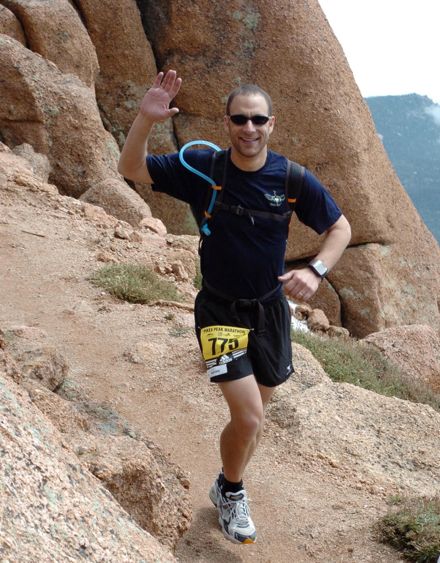
Pikes Peak Marathon Race Report (2006) – Trent Rosenbloom
Pikes Peak or Bust –
The Pikes Peak Marathon is in a class of its own, distinguished by Pikes Peak itself, one of Colorado’s most notorious 14ers. Among the 53 or 54 mountains in Colorado higher than 14 000 feet at the summit, Pikes Peak carries a reputation for challenge and a history of intimidation. Pikes Peak derives its fame and reputation from being easily visible for many miles to the east, more so than any other of the Colorado Rocky Mountains. It has long been the single goal for homesteaders and then miners headed westward. For these early westerners, Pikes Peak was once thought to be unconquerable due to its elevation, conditions and location. While it is now clear that the Peak can be readily summited by car, foot or rail, the Barr Trail up its eastern face remains among the most challenging footpaths around.
From town, the round trip up the Barr Trail to the Pikes Peak summit is just shy of twenty-six miles. It would seem logical to create a marathon that covers the up and down route, right? Well, the Pikes Peak Marathon is not your usual marathon. It is not a road race since most is on trail, and it is not a typical trail marathon because it starts and finishes on road, has a large field with plentiful aid stations along the course, and takes most participants far longer to complete than other marathons. Furthermore, because of the big mountain that occupies most of the course. For most, the Pikes Peak marathon is actually two events: it is first a long 13.1 mile fast run/hike over an average 11% grade path that includes a road, a narrow trail and numerous switchbacks and rocky step-ups to a point well above treeline; second is a tough as nails, body-beating downhill half marathon on the same course, with a clock timing the whole thing as a single event. As you climb from below 7000 feet elevation to above 14 000 feet, the air thins, your thinking muddles, your legs tire and your mind despairs. But time flies and before you know it, you are headed back downhill. Most runners cannot actually run the whole way up. Yet a few feet from the turnaround point, you feel the air return and your thoughts clear. This occurs just in time to feel the burning in your quads and back. Pace is vital; run ahead of your abilities and predicted time and you will risk burning out. Run too slow and you will risk spending too long under the dangerous conditions on the mountain. The average finish time for the past five years is 7:06 for men and 7:36 for women. Last year’s winner finished in 3:58. These are very long times for a run at marathon distance, speaking to the difficulty of this course.
This past March I signed up to run this marathon, which was a strange thing for me to do. I never really saw my self as a runner or an endurance athlete, and until recently I never put in consistent miles. I had grown up an introverted and asthmatic kid and participated in very little physical activity, instead preferring schoolwork, camping and computers. The madness leading up to my registration actually began about thirteen years ago. I remember a friend taking me to a running store to buy my first pair of running shoes. After that, the two of us would periodically run and walk/run a three mile loop near my home. My friend was always stronger and faster than I, but he patiently helped me along and to build a small base. At that time, I was in school and the running helped both to clear my mind and to challenge me. But I never ran seriously, competitively or regularly. Over time and with effort I improved, and eventually I was able to complete the three-mile loop near my home without stopping. I had many other interests and activities in my life, however, and for many years I ran only sporadically and never more than three miles. I remember back six and a half years ago when I realized that I wanted to attempt to run a marathon. I had watched folks on television running the inaugural Country Music Marathon in Nashville, TN, and figured that if they can do it, so could I. Some time later, I actually started to train. But I had no idea what I was doing, did not really take the training program I had downloaded off the web very seriously and did not properly build up my miles. I ran the second annual Country Music Marathon, bonked at mile 12, and then did not run again for three and a half years.
Things changed a little over a year and a half ago when I was inspired anew to run. My older daughter had been running cross-country in grade school and I realized that I missed the sport. Shortly thereafter I learned that I was going to be near Duluth, MN over the weekend of the 2005 Grandma’s Marathon. From friends, I had heard great things about Grandma’s Marathon: it runs along a beautiful and flat route along the shores of Lake Superior during the cool of the Minnesota early Summer. To run Grandma’s, I had only 7 1/2 months to build my mileage base back up from nothing. That very evening I tied on my old running shoes, ran a mile and didn’t collapse from the effort. The next day I ran two. Then three. Within a month, I was actually up to about 20 miles per week. With this base established, I started training regularly the following January. I first trained with a local running club, the Nashville Striders, for the 2005 Country Music Marathon. Country Music Marathon was scheduled to occur seven weeks before Grandma’s that year. My goal in training for the Country Music Marathon was to benefit from the local training program, and to allow myself a seven-week window to recover should I become injured or sick during training. By good fortune I did not get injured or sick and so I ran the Country Music Marathon, and then Grandma’s Marathon 7 weeks later. My times were not special, but I was able to keep going and completed the distance. Somewhere along the way I thought it might be fun to complete five marathons in ’05. This goal was both silly and arbitrary. But what the heck? After three marathons in the Fall, I completed this goal.
I met 2006 without any significant running goals. I wanted to break 4:00, which I did easily in my first marathon of the year, and I also ran a few tough marathons in the following weeks, including really hot Country Music and Grandma’s Marathons, and a hilly, long (i.e., it was about 26.9 rather than 26.2 miles) Grandfather Mountain Marathon. Finishing the Grandfather Mountain Marathon, I had tallied up nine marathons in 14 months and ten in my life. These were fun and it is always great to go through the finish line at a marathon. But I wanted more of a challenge.
A group from Nashville had run the Pikes Peak Marathon during each of the past few years, and they always have had great stories to tell and pictures to share. Last year they went out early and ran a few races in the weeks before and had a blast. One of them in particular, Diane, is very convincing and very nice, runs a lot of marathons and ultramarathons, and when she says “c’mon”, it is really easy to follow. So this year, when registration opened and she made sure I knew it had opened, I gave Pikes Peak serious consideration. Because last year was the 50th anniversary for the Pikes Peak Marathon, interest in the run was high and the marathon was expected to fill in less than 24 hours. I knew I had to make a quick decision. I checked with my wife (who was not sure what she was getting herself into) and she said, “Whatever you want to do”. So I registered. Once registered, I knew that I had to put my shoes where my money went. From Nashville at an elevation of 500 feet above sea level, with hills that max out at about 400 feet, I somehow had to train to complete a marathon at high elevation that climbs vertically nearly one and a half miles in elevation gain over its course, then drops the same before the finish, with the whole thing taking 150%-200% of my normal marathon completion time.
When asked to name the hardest marathon in the country, many runners name Pikes Peak. The Pikes Peak Marathon carries the moniker “America’s Ultimate Challenge”. When asked about Pikes Peak, many veterans equate it to a tough ultramarathon. They make this comparison not because of the total distance, which after all is just 26.2 miles. Rather, the Pikes Peak Marathon is equated with ultramarathons because of the long time required to finish, the strategy required for completing it, the fact that it is mostly on steep rugged trail, and that it requires as much effort as many ultras. In addition to the trail conditions, the elevation and the length, Pikes Peak adds the potential for extreme weather; it could be hot and sunny, raining and slick with lightning, or even snowing and sleeting (as was the case last year). And runners may experience all of these conditions during the course of a single run. To compound the drama, people running this thing occasionally die. As in dead. I was fortunate to have had a conversation with Jack Menard, an ultramarathoner who recently completed the Badwater 135 mile Ultramarathon that starts in Death Valley and finishes at the base of Mount Whitney. Menard stated that Badwater is just a long walk in the heat, while Pikes Peak is really tough. I think he may have been exaggerating, but there is truth in every lie. Many runners jump off from running Pikes Peak into ultramarathoning because after the Peak, 26.2-mile races on flat asphalt courses just don’t compare. What was I thinking? My wife keeps telling me that she needs to buy more life insurance for me.
Living in Nashville, how was I supposed to prepare for this challenge? How could I ensure that I would complete the marathon and come away uninjured and with positive memories? How could I do as well as possible on such a tough run? Well, the first thing I did was go over to Matt Carpenter’s website, www.skyrunner.com. Carpenter lives, trains and runs at the high altitudes of Manitou Springs, the home of the Marathon. Carpenter sets records on nearly every course he runs, including the Pikes Peak Marathon. Last year he took a break from Pikes Peak to run the Leadville Trail 100 mile Ultramarathon, and crushed the record there by finishing in 80% of the time of the prior record. Carpenter knows a thing or two about running hills and distance at high elevation. From the website, his basic suggestions for those who live close to sea level and without major mountains (i.e., so called “flatlanders”) is nonetheless to emulate the Pikes Peak Marathon as much as possible. To do that, one needs to: 1) run several times for more than four or more hours; 2) run at inclines of 10-12%; 3) run as much as possible on rugged trails; and, 4) learn as much about the course as you can. Carpenter comments that for flatlanders, there is no way to emulate the effects and feelings of running at altitude short of actually running at altitude. That said, I had received other advice that any time I spent at high elevation in the days leading up to the marathon would help. Since I have a day job and could not go to Colorado for weeks or months of high altitude training, the best I could do would be to spend a single week beforehand climbing some of Colorado’s 14 000 foot mountains and sleeping at 10 000 feet above sea level. Just a week at high elevation would not suffice to permit my body fully to acclimate. However, it would allow me to begin a physiologic adjustment, and would lead to some mental acclimatization. By that I mean I would learn what low oxygen feels like and have a sense of how to deal with the chest palpitations, dizziness, nausea and headache that it brings. It was also possible that spending the time at altitude would reduce the chance I would feel those symptoms during the marathon itself.
So I did my best to follow Carpenter’s guidance. I ran a few marathons this Spring as training runs, including another tough and hilly Grandfather Mountain Marathon in Boone, NC seven weeks before Pikes Peak. I pushed my weekly miles higher than they had ever been, purposefully flirting with overtraining. I ran fairly technical 4- and 7-mile trails that include some major steep climbs and descents. And I read the Pikes Peak Marathon route description several times. I ran as often as I could in the boiling hot and humid Middle Tennessee Summer to grow accustomed to running dehydrated and under uncomfortable conditions. Then, having done all I could in Nashville, I went with our local Pikes Peak Marathon group to Colorado nine days before the marathon to run, climb mountains at high elevation and begin to adjust to the altitude. The marathon was on Sunday, so we flew out to Denver Friday a little more than a week before to begin the process.
Our plan for the week was to spend as much time sleeping, sitting, hiking and running at high elevation. Saturday, we ran the Georgetown to Idaho Springs Half Marathon. The run started at 8500 feet elevation, then dropped 1000 feet over its course, despite a few rolling ups. I ran feeling short of breath and lightheaded, with heavy spaghetti legs the whole way. All the runners in our group ran about a minute/mile slower than our usual half marathon pace. Upon completing the half marathon, we went to Leadville, Colorado to spend a couple of nights sleeping at an elevation of 10 000 feet above sea level. On Sunday we ran the Leadville Trail 10k over a course that covers the first three miles of the Leadville Trail 100 mile run, and goes down a 400-foot steady drop over the course of 3.1 miles. At the halfway point you turn around and return to the start up the same hill. Again, we all ran relatively slow, and my pace was a little more than a minute slower than my usual 10k pace, but one member of our group took 4th overall, beating out many of the runners who are well accustomed to the altitude. The next day, Monday, we climbed Colorado’s highest peak, Mount Elbert. The climb covered 4.6 miles and rose an average 23% (and a maximal 50%) grade, over trail, piled rocks and scree, with no real switchback to soften the climb. We spent an hour at the summit, over 14 300 feet, eating cold pizza and granola bars. From the summit, we RAN back down to the cars to get a feel for running down from high elevation, with a severe grade and on a questionable surface.
On Tuesday, we drove up Mount Evans to get more time at high elevation. Mount Evans is another Colorado 14er and has the highest road accessible point in the country. We drove to avoid overexerting ourselves in the week before the marathon and to allow some recovery from the efforts the days before. Just below the summit, at about 13 000 feet, there is a lake (called, surprisingly, Summit Lake) with a few nice trails around it that we hiked. Of course, our hiking was limited by the growing pain in our quads and calves from that 4 mile downhill run the day before. On Wednesday, well rested, we climbed another 14er called Mount Democrat. Mount Democrat required climbing an average 23% grade, but this was mostly over small boulders and scree through a poorly marked trail; the 2 mile climb took almost as long as the 4 mile climb up Elbert. After an hour at the summit elevation, the icy wind and menacing dark clouds convinced us to head back down. Halfway down, we decided to call it a day rather than attempt the adjacent 14ers, Mounts Lincoln and Brosse. On Thursday we drove back up to Mount Evans to spend the entire afternoon at elevation. We sat atop the summit reading and relaxing for five hours through changing weather that brought sun and 60s at one moment and sleet and snow with a cold wind at another. Elevation training done to the best of our abilities, on Friday it was off to Colorado Springs to get ready.
Marathon weekend brings two events to Pikes Peak: the Ascent, a 13.32 mile race from Manitou Springs up the Barr Trail to the summit on Saturday; and the Marathon, a 26.2 mile round trip from Manitou up to a point just below the summit, then back down to town. Approximately 20% of the runners participate in both events, accomplishing a feat known as the Double. One member of our group, the same Diane who got me out here, signed up for the Double. The rest of us tried to retain a small shred of sanity by running just the Marathon or the Ascent. Our plan was to arrive in Colorado Springs, pick up our packets, visit Garden of the Gods (an attraction comprised of beautiful red-rock boulders balanced at precarious angles, rising above a conifer forest, then grab dinner and get some sleep. The next morning, Diane was to awaken early and go to the Ascent, and we would drive up on the road that wraps around the Peak to meet her at the top. We registered and went to the small marathon expo at the center of Manitou Springs. There, we met a few other runners, including the publisher of the magazine Marathon and Beyond and, by sheer coincidence, one of the people who registered for the Harpeth Hills Flying Monkey Marathon, a new tough and hilly marathon in Nashville that I have had the pleasure of organizing. After a quick dinner and a trip to Target to stock up on some last minute gatorade and dark chocolate M&Ms, we all went to bed. The night was punctuated by numerous intense storms with powerful lightning and earth-shaking thunder. The quantity and persistence of the rain was uncommon for Colorado Springs, and threatened to make the trail conditions tough for the Ascent, washing out deep ruts and pushing boulders into the way. Diane woke up dutifully and took off on the Ascent. After a pancake breakfast, we hopped into the minivan and drove to the densely fog-enshrouded summit to meet her and breathe just a bit more 14 000 foot air.
Waiting for Diane at the top, we had the opportunity to see many of the Ascenteurs finish and talk to them about the nature of the trail, the weather and the effort. We learned that, for the Ascent, the dense clouds kept the course cool and that the rains of the night before did not wreak too much havoc on the trail itself. While there were a few wet or washed out areas of the trail, it was mostly intact. At the summit, the bright yellow finish line banner was obscured by the fog; one could barely see it from just a few yards away. As each runner crested the final switchback, an announcer would call out their name and hometown. Because of the fog, this was nearly the only way to know who was finishing. But runners finished and emerged from the fog to begin their recovery. The top finishing times for the Ascent was 2:18 for men, 2:46 for women. Diane’s plan was to finish much later to ensure that she had enough energy to complete the Double the next day. So we sat near the finish line in the icy and foggy cold, enjoying the excitement and watching everybody finish. We occasionally went into the Summit House to warm up and eat. And yes, while there I did enjoy the fudge, hot cocoa and the “World Famous Donuts” in the Summit House. The thin air, you see, makes the donuts puffy, crispy and greasy. Yum!
Sitting atop the summit, we also recognized the significant changes that had occurred over the week in our physiologic responses to the high altitude. When we arrived, even walking at an elevation of 10 000 feet above sea level would cause our hearts to race and our heads to spin. Atop Pikes Peak waiting for Diane, we found that we were much more comfortable. Seven days before, in Leadville, my resting pulse was in the low 90s and around 110 while walking, compared to my pulse in Nashville, where it is usually 56-58. Sitting the day of the Ascent atop the Pikes Peak summit, 4000 feet higher than Leadville and over 2 1/2 miles higher than Nashville, my pulse was just 80. And I felt comfortable walking around, was not lightheaded and could think fairly clearly. I had made definite progress against the effects of altitude, our week in the mountains seemed to have helped. The diminished effects of high altitude combined with the relatively fresh appearance of Ascenteurs finishing in about the time I expected to summit the next day reassured me.
Well, Diane finished feeling strong. We drove down the mountain to get some food and some rest before the big run.
***
Purple Mountain’s Majesty –
Marathon morning began with our hotel wake up call at 4:45 AM. The weather forecast was calling for partly cloudy skies with a temperature in the 60s at the starting line, 30s at the summit and 70s at the finish. With the fog and rain the day before, marathon morning was offering beautiful mountain weather. We collected the items we would need for the run, including fluids, energy gels, sunscreen and sunglasses. A quick bite at Denny’s, and we were off to the starting line. The sun began to rise as we drove to Manitou Springs, lighting the top of Pikes Peak in a brilliant orange glow. Beneath the peak, there were a few wispy clouds that had settled into the alpine valleys just below treeline. The deep blue sky framed the orange peak, the silvery clouds and the dark green forests as the scene dominated the western horizon ahead of us as we approached the marathon. Once there, we joined the crowd of runners, all lining up for pictures with the mountain in the background and the starting line banner in the foreground. I bumped into a couple of runners I knew and we too posed for pictures in the crisp morning air. We were just a few moments before the starting time, and we felt the excitement rising.
The Pikes Peak Marathon starts and finishes in the town of Manitou Springs, just outside of Colorado Springs. The course climbs from town up to the Barr Trail. The Barr Trail is an approximate 12-mile path that winds its way from the base of the mountain, up over Mount Manitou and then up Pikes Peak to the summit. The trail includes over 250 switchbacks, large boulders and roots, scree fields, dense forests, streams, mountain and valley views, vast boulder-strewn expanses above treeline, and several structures built at different times during Pikes Peak’s recent history. Many of these landmarks serve to mark the runner or climber’s progress up the trail towards the summit. While there are also mile and elevation markers, marking progress by miles is fraught with problems. Running up the Barr Trail, with its changing grade, terrain, available oxygen and topography forces the runner substantially to vary pace at different places. The effort required to run the first mile at a given pace is very different from the effort required to run the twelfth mile at the same pace. Carpenter’s advice is to determine a goal time to the summit and then use race statistics from over the years to determine approximately how long it would take to reach certain landmarks. To help with this, his website offers a calculator which estimates landmark-based intervals. Using the calculator, the time to reach the landmark known as Barr Camp, a structure about halfway into the run and 10 000 feet above sea level would take 50.8% of the ascent, or just over two hours for a four-hour ascent. Armed with the expected times to the various landmarks along the way up, the runner should be able to adjust their pace so as not to run too fast or too slow.
The approach to the Pikes Peak summit includes several other landmarks indicating how far you have gone in terms of a percentage of the total effort to reach the top. Estimating when you should pass each landmark requires that you have an idea how long it would take to get to the turnaround point at the top, 13.32 miles into the run. Having never run the Pikes Peak Marathon, I did not know the appropriate time it would take me to reach the summit given my abilities. The common rule of thumb is that, for flatlanders like me, getting to the summit takes your best recent marathon time plus 30 minutes. For example, if you can comfortably run a four-hour standard marathon and you have adequately trained for Pikes Peak, you should be able to reach the halfway point near the summit in about four hours thirty minutes. Getting back down to the finish line requires another 60% of the summit ascent time. I had completed my last fastest marathon in 3:50, which would predict 4:20 to the summit and a little over 7:00 to complete the marathon according to Carpenter’s calculator. Given that the average male finisher time over the past few years was 7:06, I decided to shoot for a finish time of 7:00 or less. To achieve a 7:00 marathon, and assuming that I would follow the split schedule as predicted, I would need to summit by 4:18. No problem, right? So I wrote down a pacing chart that included the major landmarks along the way, and the times I should reach them if I were to run a 7:00 marathon. I also wrote down the times for a 6:30 marathon, just for kicks.
Given that the thin mountain air would become even more sparse as I climbed the mountain, I elected to use my heart rate to help guide my marathon effort. This would supplement other information I had while running, including my general sense of wellbeing, the strength I perceived in my legs, my thirst and my hunger. I planned to maintain a heart rate between 155-165, which should represent a sustainable effort. In addition, given the tough incline that I would have to climb, my heart rate would serve as a guide for when I could speed up and, more importantly, when I needed to slow down or walk. However, I also knew that the altitude and thin air could cause my heart rate to climb higher or, weaken my effort to the point where my heart rate would drop lower. My monitor included GPS capabilities, so it would help me gauge distance covered and elevation above sea level. These data would be equally useful to help me monitor progress both in terms of linear distance and climb up the mountain. I could use the information to check off every altitude landmark as I ascended from 6300 feet to 14 050 feet, and again as I descended.
The race started in the heart of scenic Manitou Springs. There, with a couple of minutes to go before the start, the race director made the usual announcements to inspire us and make sure we understood the rules of the road. Then, a choir of school children sang “America the Beautiful”, which was inspired by Pikes Peak itself, and was written after the song’s author, Katharine Lee Bates, visited there in 1893. The singing before any race can evoke an emotional response, but standing there with the Pikes Peak summit in sight on a beautiful and cool Colorado morning after months of preparation and angst, I became choked up. My sunglasses hid tears of joy, excitement and nerves as the children sang and the crowd grew silent, just seconds before the starting gun. And then, “on your mark, get set, go”, a gun shot into the air, and we were off.
***
Oxygen is Overrated –
The first section of the Pikes Peak Marathon course goes through the center of Manitou Springs, along Manitou Avenue and among hundreds of cheering spectators, then veers left up to Ruxton Street and Hydro Street as it makes its way up to the trail. On the side of the road, Trish, who ran the Ascent and who is the wife of one of the runners in our group, was cheering us all on and calling out our names as we went by. Another spectator was blasting the tune from Chariots of Fire (a movie more about fast short distance running, but no matter, it is always inspirational). While running, the field thinned just a bit, and many people quickly passed me. I had been warned to take it easy and let folks pass; either they had the ability to maintain their pace, or they would quickly burn out on the long road ahead. The morning remained cool as we progressed up the hill towards the Barr Trail. My times to the first two landmarks were ahead of schedule: 4:37 minutes:seconds to Ruxton versus 5:17 for a 6 hour 30 minute run, or 5:41 for a 7 hour run (herinafter listed as actual time/6:30 finish predicted split/7:00 predicted split, or 4:37/5:17/5:41 for Ruxton, then 14/15/16 for Hydro Street). I was ahead of schedule, and felt good and light. My heart rate was right at 160, I felt air in my lungs, my thinking was clear and my legs felt pretty limber. A good start, and I hoped it was sustainable.
Shortly after passing the Cog Railway, a railroad that carries tourists up and down from the Pikes Peak summit, we turned right and entered the trail. The trail begins with a series of thirteen switchbacks, known as “The Ws” because of their appearance as stacked Ws on a map. There is one aid station at the bottom, and another just below the top of the Ws. The trail itself is made up of a narrow, single track path with rocks, roots and steep sides that all together make passing prohibitive. The term single track means that the trail is wide enough for a single runner only, and at times the designation seemed to have been an exaggeration, so narrow is the Barr Trail. Much of the trail on this section is also steep as it traverses through a dense conifer forest, still misty with the morning humidity. On this section, many of the runners were vying for position, passing each other when they could barely squeeze by. I passed a few people in this section, and other runners passed me. At the top of the Ws, after taking some Gatorade Endurance Formula and some grapes at the aid station, I found myself even more ahead of schedule, 43/48/52. At this point, I did not feel quite as strong from the recent climb, but my heart rate remained in my target zone and my thinking remained clear. So on I went.
The next portion of the route winds through the woods and includes a few small climbs, switchbacks and flat sections. In this part of the marathon it is fairly easy to establish a running rhythm and simply to float on through. The hills often required fast walking to climb, but the flats really allowed some smooth running. During this part of the run you get your first glimpse of Pikes Peak. In the hour that had passed since the start of the run, the Peak had become even more spectacular. At this point, it filled the view, framed by the dense green forest and the large granite boulders jutting out above the trees. Some wispy clouds remained in the valleys above and below, and the sun was at just the right angle to illuminate the entire scene. As we ran through the hills below Mount Manitou, in the foothills of Pikes Peak, the views were continually breathtaking. I almost stopped on several occasions to dig out my camera and take pictures, always a great temptation for me, but I was still feeling good and wanted to press on. Shortly after ducking under a natural granite stone arch and climbing another hill, I reached the next landmark, the No Name Creek and aid station: 1:05/1:10/1:15 hours:minutes. I was still ahead of schedule, my heart rate still in zone, and I felt reasonably good. I drank some fluids, ate some grapes and energy gel, and then moved on.
Above No Name Creek, the trail climbs higher through more woods and includes a traverse over to Pikes Peak proper. This section ends at the Barr Camp, an old lodge on the mountain. According to the calculated splits, runners should reach Barr Camp in just over 50% of their total ascent time. As before, this section mostly winds through the forest, over generally well-kept trails of dirt and gravel, with occasional tree roots and clusters of small to medium sized granite rocks. The technical quality of the trail and the climbing grade forces the runner to pay attention with every step. There are occasional views of the mountain above in the clear open sky, and the city below, now mostly enshrouded in low-lying clouds. At this point, the running field had thinned considerably, and you could see only a handful of runners ahead and behind you. Passing runners was fairly uncommon at this point, although it did occur at the aid stations along the way. As I climbed higher, I began to notice that my legs felt heavier and heavier and that I began to feel weaker. I was not lightheaded. I was not nauseous. I was not dizzy. Mostly I just felt tired and a bit sluggish. I remained ahead of schedule, but by a shrinking margin: 1:30/1:35/1:42 to the sign that says 7.8 miles to the summit, and then 2:00/2:01/2:11 to Barr Camp. My heart rate had begun to drift lower at this point, and now mostly rested in the high 150s, suggesting that my actual effort was dropping while my perceived effort was increasing. But I pressed on. Just past Barr Camp was the seven mile marker, and my elevation was just over 10 000 feet. I was more than halfway to the top, and still moving forward
The trip from Barr Camp to the treeline is the trail section where most runners really feel the air thin, the elevation climb, their legs slow and their heads spin. There are numerous switchbacks, steepening climbs, and more obstacles on the trail. The trees remain dense, but the clearings come more frequently, the pines become more stunted and scrubby, and large orange-red and white flecked Amanita Muscaria mushrooms are everywhere along the forest floor. Here, those marathoners who are still running finally begin to walk, and the rest of the field begins to walk more slowly and with more attention to pushing each foot ahead. Step by step. The trees begin to thin and the bright sun becomes more intense. From here, hydration, sun protection and determination all become more important. I continued to push forward, but by this point my legs had begun to feel notably heavier, while my heart rate remained in the mid to high 150s. The elevation gauge on my GPS device kept climbing, which was a reassuring sign. But the work was beginning to get hard, and I began to feel the first thoughts of despair: What am I doing? Can I finish this? As I approached the treeline, marked by an A Frame cabin and another aid station the leader, Matt Carpenter, came flying back downward towards his finish. He appeared as something between a gazelle and a sparrow. And then he was gone and my climb continued. I made it to the A Frame somewhat slowed, but still ahead of my schedule: 2:55/2:50/3:03. The A Frame is at an elevation of about 12 000 feet above sea level, and just below the spot where the trees gave way to the tundra and open boulder fields that continued all the way to the summit. I stopped, took some deep breaths, a few cups of fluid, some energy gel, some Jelly Bellies (yum!) and some grapes. After a minute or two I felt a bit refreshed, and took off to complete the last three miles of the upward climb. Past an old burnt forest marked by barren weathered tree trunks interspersed with scraggly pines, and I was above the treeline. By definition, trees do not grow in the conditions above treeline. My wife has commented that there must be a lesson in this fact.
The rules change above treeline. That’s the general dogma for climbing or running up mountains. In this case, that means all the pace plans go away and any forward motion towards the summit is good. Climbing the remaining 2000 feet of elevation in over three miles to complete the climb up the Barr Trail generally takes the ascenteur far more time and effort than anything that came before. Add to that steep switchbacks which do little to flatten the climb, closely placed boulders that you must slow to climb over and substantially thinned air, and there was no good way to predict how long this section would take. Even the fastest runners struggle here, and nearly all of them walk or crawl. According to my schedule, it should take between 65 and 85 minutes to finish the climb. Along the way I would pass three major landmarks, each one attesting to my progress across the otherwise featureless rock field: the 2 miles to summit sign, the Cirque–a scenic view from a 1400 foot dropoff to the valley below–and the 16 Golden Stairs, a set of 16 switchback pairs just below the turnaround point. While these points indicate progress towards the summit, they also point out the runner’s ever-slowing pace.
On this morning above treeline there were large patches of fresh snow covering and surrounding the route, as well as snowmelt turning many trail sections into small streams. The air was cold, about 36 degrees according to the signs on the way up. A strong wind blew across the boulder field that made up our route, sometimes to our backs and sometimes to our fronts, as we zigzagged up the switchbacks. Looking forward I could see the summit, still appearing far away and high above, but now with a visible stream of marathoners winding up from where I was enduring my own struggle. Occasionally somebody ahead would call out, “runner” as one or more of the faster marathoners would come craning down the path, headed back to oxygen, the trees and the finish line. In the meantime, I was part of the slow march upwards. By this point, my heart rate was bouncing between 147 and 153, my legs were heavy as lead, and my head occasionally spun with exertion. I felt forced to take occasional breaks just to regain my focus and breath. At one of these a woman stopped, looked into my eyes and asked me if I was okay, and then did not seem to believe my reassurances that I was. But she eventually moved on and soon I too pushed forward. In most marathons, the runner begins to encounter a feeling of despair and doubt around mile 18 or 20, wondering just what they are doing running such a distance. During the Pikes Peak Marathon, I experienced this doubt around mile 11. But I had to push on and up. Slowly on and up I went. I made it to the 2 miles to summit sign still ahead of schedule, but just barely: 3:20/3:14/3:29. And then up past Cirque. And then up past a few switchbacks. At 3:50, two friends who were also running the marathon passed me on the way back down to the finish, both focused on the route and both appearing happy to be headed towards the air.
Soon it would be my turn to head down as well. I continued to traverse the steep stone fields. I passed more landmarks. One mile to go. Then the Golden Stairs. I counted them off, some switchbacks short, some long. I counted them, one, two, three, four, and so on. The rocks were slippery. Each switchback required a big effort to climb. I occasionally had to use my energy to move aside for a downhill runner. There was no air. My heart rate was dropping even lower, as my perceived effort continued to climb. But as I got closer to the summit there were people yelling and clapping and shouting encouragement. These were spectators who had driven up or taken the Cog Railway to witness the turnaround. Trish, who cheered us far below and long ago, was at the top again calling out my name and holding up a sign. Fifteen switchbacks, sixteen, seventeen. I could see the turnaround sign, hear the music, feel the top. Twenty six, twenty seven, twenty eight. And then, I was there. I reached the summit, took a few breaths of air, some fluids and grapes and looked down at the mountain. I made it right behind my goal time: 4:19/4:00/4:18. But that was fine; I hoped to make up that minute on the downhill. And so after one last look around, downward I went.
On the way down, within a few steps, runners suddenly can breathe, feel the strength return to their legs, and notice their heads clear. My experience was no different. I was barely below the Golden Steps and I felt like I was running a new race, albeit on tired legs. Now it was my turn to have the right of way; all the marathoners coming up moved to the side to allow me to come down. In my renewed excitement, I plummeted downward with near-wild abandon. Several other runners tentatively heading downward made room for me to pass as I flew by. I saw several friends headed upwards and I passed along the same encouragement I had received from downhill runners as I headed up. I was so excited to be moving that I stopped only briefly at the first few aid stations for fluids. And while some of the switchbacks and boulders required that I slow down, for the most part I found that I could run smoothly and consistently. My pace improved from approximately 15 minutes per mile on the more technical sections up high, to 12 minutes per mile as I passed below treeline, and then to 10ish minutes per mile below Barr Camp where oxygen awaited me. The trip down was great fun as I dodged the rocks, roots and ruts in the trail, passed numerous runners and vied for position with others, stopping occasionally to grab fluids and candy at the lower aid stations. There were a few small uphill sections that felt great on the way up the mountain, but were difficult on the way down; many of these we walked. The trail wound its way down all the switchbacks we had previously climbed, through dense forests and among light clearings, with occasional mountain and valley views to distract from the mounting fatigue. On the way down, I saw a few runners who had fallen while running at speed on the trail; many had gotten injured. One was covered in blood and bandages after receiving stitches for her injuries.
Heading downward, the time flew. I passed each mile marker, keeping a close eye on my watch and pace to make sure that I would reach my goal time of seven hours. At treeline, with ten miles to go, I had been running about a fifteen minute pace and had two hours remaining. I would not make it. Three miles later, at Barr Camp, I had seven miles and an hour and twenty minutes left, and was running at an increasing pace. I might make it. The further down I went and the more my pace increased, the more confidence I had that I would make it. In the last few miles, however, another factor emerged; it was becoming fairly hot and humid. I knew that I was sweating and losing fluids and salts. I stopped to drink more at every aid station, but my increasing pace made it hard to digest the fluids comfortably. I found myself in a tough place; as I descended, I began to cramp from the drinking, and began to feel a little weak from not drinking enough. I was close to the finish and ultimately decided that it was best just to push on. Fortunately, the aid stations were placed regularly enough that I could take small amounts of fluids frequently and keep an even pace. And I found the descent portion the easiest second half of a marathon I have ever run.
And so on I went, headed to the finish and hoping for a sub-goal time. Down past Barr Camp. Down across the traverse to Mount Manitou, then onto Mount Manitou and No Name Creek. I kept a close eye on my altimeter: 11 000 feet elevation, then 10 000, then 9000. Down through the granite natural arch. Down several switchbacks and some significant steep drops that I did not really remember from the climb. Down to 8000 feet. Then 7000 feet. Three miles to go, then two. Then the Ws, counting them down. At the bottom of the Ws, somebody was again playing Chariots of Fire. Then, immediately past this, one mile to go, and again I became choked up. And then asphalt. And then cones to guide us. And then a steep downhill. And then turn the corner to Ruxton Avenue. And then the crowds started to appear with kids waving for high fives. And again, Trish calling out my name and holding up a sign. Excited to be nearly done, I threw my Camelback to Trish so I would not have it in the finish line photo. And then down through the enclosing crowds and swelling cheers. There is my name and hometown being announced. And then around the corner, the finish line. And I was done. 6:48:17. Ahead of schedule and happy as can be.
– Trent Rosenbloom (2006)
Posted in Marathon, Race Reports, RunningComments (0)

Posted on 23 August 2012.
This is the medal for Pikes Peak Marathon that was held on August 19, 2012 in Manitou Springs, Colorado.
The marathon starts at 6,300′ and climbs to 14,115′ at the summit before the runners return back to the start! Insane! It’s America’s Ultimate Challenge all right. I like how the medal incorporated the mountains into the shape and that it declared the marathon’s bada$$ery on the back.
Congratulations to RIF #83 Brad Box and RIF #1 Joshua Holmes for completing such a tough marathon!
Here’s one last photo of the medal:
MORE PHOTOS OF MARATHON/ULTRA MEDALS AND BUCKLES
[Medals and photo submitted by RIF #1 Joshua Holmes – follow him on Twitter @bayou]
Posted in Bling, Featured, Marathon, MedalsComments (0)